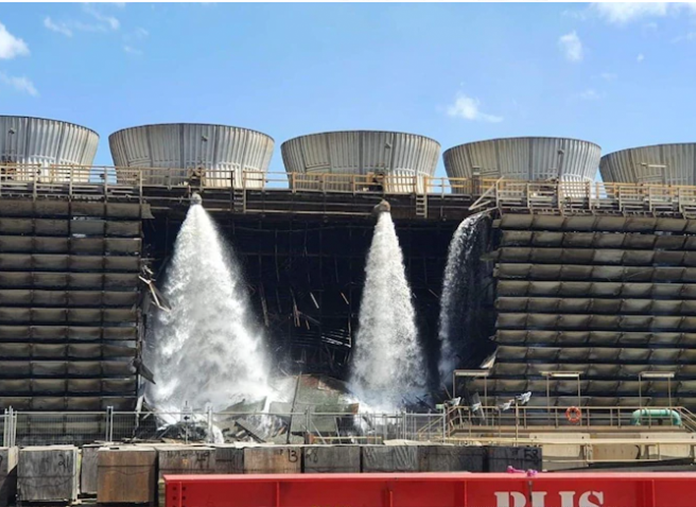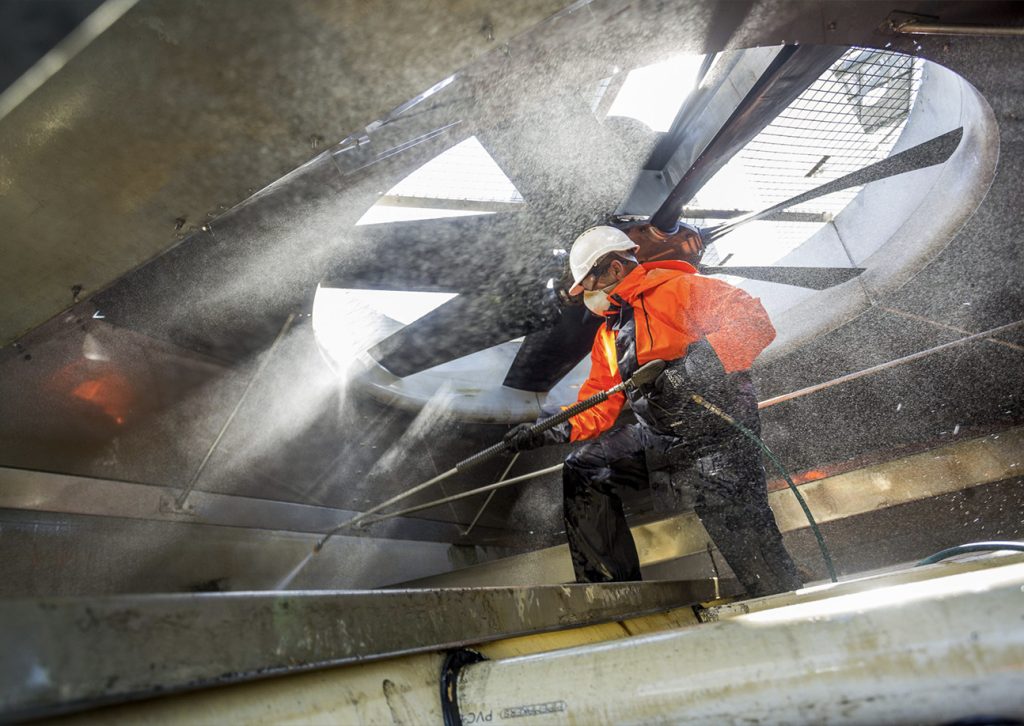Breaking news came out over two weeks ago, about part of a major central Queensland power station being offline after the structural failure of two cooling tower cells for their cooling plant.
The incident occurred at the cooling plant of the Callide Power Station’s C3 Unit on Monday, 1st November, the operator CS Energy confirmed.
Luckily nobody was injured when the incident occurred. Unit C3 has been taken offline as a precaution, with restricted access to the area. Mining and Energy Union Queensland vice president Shane Brunker said, it appeared “too much water” was being pumped, which caused the cells to collapse.
He said he believed more water was being pumped because the unit was trying to produce more power to keep up with the demand caused by higher temperatures across the state.
“They’ve had to pump more water through to keep the systems cooler and then the failure occurred,” Mr Brunker said.
It is the second incident in just under two years at the power station, after the C4 unit caught fire and exploded during a catastrophic incident on May 25, 2021.
No-one was injured in that incident either, but some 470,000 homes and businesses across Queensland, from north of Cairns down to the Gold Coast, were left without power.
The CS Energy spokesperson said the C4 Unit is expected to return to service in April next year.
https://www.abc.net.au/news/2022-11-01/structural-failure-at-callide-power-station-c3-unit/101602444
By Tobi Loftus and Paul Culliver
Did “pumping too much water” into the cooling tower cause it to collapse?
It shouldn’t, but it did.
Regular Cooling Tower Maintenance should avoid these situations
Because of this incident, we wanted to get some insight from an industry expert to learn more, but to also question whether “pumping too much water” into a cooling tower can indeed leave it to collapse this way?
We sat down with Jason Christensen, a director at FlowMatrix who has extensive knowledge of all things cooling towers. Jason’s experience is as follows, ten years as a cooling tower industrial water treatment technician with Solenis, three years doing specialized coating applications with Select Coatings, and is now on his fifth year with FlowMatrix as a General Manager and director in 2022.

Jason Christensen, General Manager
We asked Jason some questions relating to this news article, and to capture his raw and honest answers
Q- “With your knowledge and experience, what do you believe actually happened here”
Jason said “Basically what’s happened here is a failure that should not occur. A cooling tower is designed to operate under full water loading, but there appears to have been an extreme lack of maintenance and probably a lack of repairs to the fill pack below the hot water deck itself. This looks to have caused the collapse of the deck and the fill pack.
So, it’s critical that you’re doing a six-monthly maintenance plan on your cooling towers to inspect your fan drives, your hot water decks, your water nozzles to ensure no blockages, your hot water distribution decks, inspecting all your drift eliminators, all of your fill pack, your basins, your columns, your structure casing, all those components to make sure it’s safe and sound.”
Q- “So according to what you just said, it could be so many other things, not just too much water, is this correct?
Jason said “Obviously in this case, as there must have been some major issues that caused the failure as excessive water flow should not be an issue. It could have been faulty or corroded bolts, it could have been broken timbers, fouling or blockages of nozzles, faulty fill pack, or multiple things, which could have been picked up on a six-monthly maintenance check.”
Q- “It’s extremely shocking to know that the same thing happened two years prior to this incident, so why do you think that maintenance was not performed on this cooling tower?
Jason said “Yeah, well, some of these issues can be expensive to deal with and do require a cooling tower to be partly shutdown to do maintenance and repairs. It can involve putting in brand new components such as fill pack or drift eliminators, repairing the hot water decks if they are collapsing, unblocking nozzles. But obviously, the impact of having it collapse is quite significant, affecting 470,000 homes and businesses across Queensland and the massive pollution of the water treatment chemicals that flooded over the plant room, with all those nasty chemicals that are used to kill up bacteria now in the ground.”
Q- “What does this power plant now have to do going forward, how big is the impact they now have to face?”
Jason said “They’ll have to run on one cell being down, so they’ll then scaffold it, and they’ll pull out all the old components that’s collapsed and then they’ll put new supports back in, new drift eliminators and rebuild the whole thing. And therefore, it’ll take some time, and also incur significant cost.
They’ll probably have to bring in some hire equipment like chillers to give them the cooling duty while they’re doing all that work. It could also be additional cooling towers that they plug into the system to help it cool while the damaged one is being repaired. So that’d be a massive cost to them, which would probably get passed on to the consumer anyway.”
Q- “So this issue also impacts consumers and the public as well?”
“Yeah, it’s not just that they’re costing themselves money or putting people out with no power, in this case, it’s also probably going to cost Queensland public because as you know, cost will be passed on. Could have been a huge safety issue to site personnel as well.”
Q- “Why is there no regulation to ensure that this has to be done every six months to avoid this from happening?”
Jason said “There’s a regulation for cleaning but sometimes large companies are exempt from having to do this as they cannot have the cooling tower offline for too long. We have been finding that cleaning is not the correct kind of maintenance that needs to be done. The industry tends to have water treatment guys cleaning cooling towers, but they are chemists and are not trained to address cooling tower maintenance. I really need the industry to understand that cooling towers must be maintained every six months, and not just cleaned. We need professional cooling tower people in there that are qualified and trained to do cooling tower work, not people who are just there to put a hose in, some chemicals, and clean them.” These guys know how to kill bacteria but no idea on how to stop the collapse of a cooling tower hot water deck or fill pack.
Q-” In the article, they have suggested this has happened due to the change in climate for the summer and needing to pump in more water, is this true?”
Jason said “Basically, your cooling towers, they don’t need to run as hard in winter as they do in summer when it’s hot.
In the hotter months, I would just increase the flow up to its original design capacity, but this is not adding any extra water. It’s just that because of the heat of the day, they need to put all the design water flow over the cooling tower to get it to work, to get the cooling duty.
So obviously they put it up to full water flow and the things failed because of the lack of maintenance and repairs to the cooling tower.”
Q- “What would you recommend to cooling tower owners moving into the months of summer to avoid an incident like this?”
Jason said “What FlowMatrix is focusing on is we need to maintain our cooling towers every six months, so that should happen obviously twice a year. And you want one of those to happen in between, say, March, April, May, June, July, August, and September all that maintenance should be done in those six months while the systems are not at full capacity so that any faults can be identified.” Fine the faults in winter and repair before the hot weather heat hits!
Q- “Does the type of cooling towers effect different scenarios?”
Jason said “It really doesn’t matter whether it’s an industrial cooling tower, commercial or just like this one. The problem is the same, as if you haven’t looked after things properly in those cooler months, when the cooling tower is in high demand when it gets hot, that’s when all your faults will occur. We have many companies right now trying to get maintenance work done or repairs done because things are starting to fail and all because they haven’t done any maintenance.”
“The consequence for these companies now is that they can’t get the parts straight away as cooling tower parts are not easily available. I mean, most of these cooling towers are custom-made, and you could be waiting, let’s say, four to twelve weeks before the part arrives from overseas or to be built locally.”
“You’ve got to be ready, even buy the parts early, so that you have them in storage. If it does go wrong, you can actually have them on hand to put them in.
Get in early, get an inspection, find the problem, and fix it before you need to come up to full speed it the heat”
Q- “What are some of the things that can happen inside a cooling tower to cause an incident like this?”
Jason said “Most failures coming into full operational conditions will be fan drives, motors, pumps, things that start to go from occasional use to full operational speed. Additional decks will block up, and in this case, you’ve seen a fill pack collapse that is no different to a cooling tower fill pack and an air conditioning tower that’s all blocked up and failed, and that hasn’t been serviced properly. We’re talking about the cleaning industry, which is not effective. They need to be maintained. Maintenance is about pulling the whole thing apart and checking every component, making sure they’re ready to go functional and safe to work.”
Q- “Do you think you will start to see more of these incidents happening?”
Jason said “I can totally understand how people are a bit short of money now with interest rates rising and even a lack of labour, and also maybe they can’t do this work themselves internally. Perhaps it’s time to look externally for professional companies to come in and provide them with maintenance, advice, and assistance.
It does matter to get someone in to have a look, provide a quote on your cooling towers, or pay for a six-monthly maintenance inspection.
This gives them that peace of mind that they’re ahead of these things and not waiting for a disaster to occur.”
Q- “Can this happen to any kind of cooling tower?”
Jason said “This is a particular timber tower, but the same applies to steel towers or fibreglass cooling towers. FlowMatrix have trained people to deal with any type of cooling tower. There are obviously a lot of towers out there that have the same configuration, but they are made from different materials. FlowMatrix has the expertise and knowledge to deal with all those types of towers using genuine parts. So, it doesn’t matter what you’ve got, we can actually offer our expertise and services to any type of tower out there.”
Q- “Do you guys at FlowMatrix provide maintenance, advice and assistance?”
Jason said “Absolutely. That’s part of our service line to offer maintenance programs for cooling towers. And obviously, then, as we find faults, we quote the customers to repair them, it’s an all-inclusive top service that we offer. We’ll do a full catalogue of all the items in the cooling towers, and we’ll record all the pumps and motors and bearings of shafts and fill pack and drift eliminator details so that we have a record of what’s needed if something does go wrong. And we can also recommend which parts should be held in stock just in case something did go wrong.”
Q- “In your expert opinion do you think that there should be a legislation or regulation on people maintaining their cooling towers?”
Jason said “Well, the water treatment companies argue that the regular cleaning of the cooling towers is enough, but we believe that cleaning has nothing to do with maintenance.
We need to point out the difference that cleaning a cooling tower is not maintenance!” Maintenance requires cooling tower professionals
“Water treatment companies are chemists, right? They’re there to do the chemical analysis and treatment of a cooling tower. They don’t know how to do the maintenance of a cooling tower. So, it’s about time the industry woke up to put professionals in there to do the maintenance of cooling towers and make sure the cleaning is considered an action to control bacteria. The cleans also need to be a mechanical wash with pressure cleaners; as it physically removes the bacteria and dirt off cooling tower components as dirt and bacterial rot components and corrode steel bolts that hold a cooling tower together
“Thank you, Jason, for all this amazing insight and information you really have a massive understanding to the industry”
“You are most welcome; I hope someone is able to take something from this”
Be safe when it comes to your cooling tower, let the professionals handle all your needs, allowing you to always have peace of mind for yourself, your employees, and your business.
Call FlowMatrix to come out and have a look at your cooling tower today.




